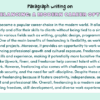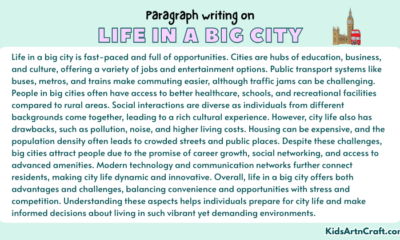Paragraph Writing
Paragraph on Education
Create practice paragraphs on the topic “Education” in four styles—Expository, Persuasive, Descriptive, and Narrative. We also guided students to write these paragraphs using different structures such as PEEL, TEEL, TEXAS, and the Hamburger method.
Most of our paragraphs are in 150 to 200 words. You can also find longer paragraphs (in 300 words) on ‘Education’ or essays on the same topic on the web.
Different Styles of Paragraphs on ‘Education’
1. Expository Paragraph on Education (Explains with Facts)
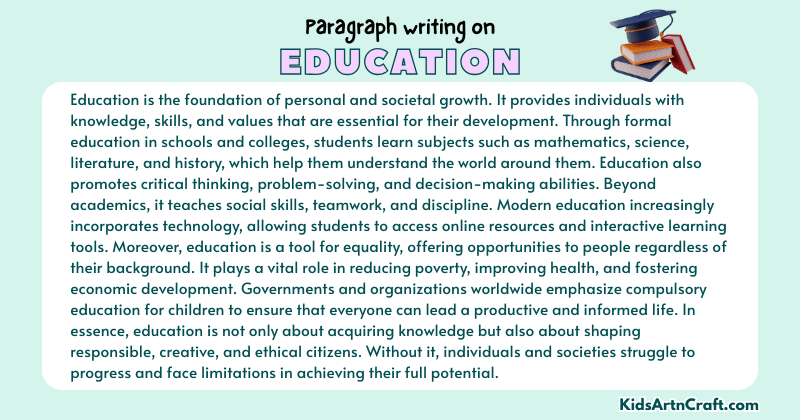
Education is the foundation of personal and societal growth. It provides individuals with the knowledge, skills, and values essential for their development. Through formal education in schools and colleges, students learn subjects such as mathematics, science, literature, and history, which help them understand the world around them. Education also promotes critical thinking, problem-solving, and decision-making abilities. Beyond academics, it teaches social skills, teamwork, and discipline. Modern education is increasingly incorporating technology, enabling students to access online resources and interactive learning tools. Moreover, education is a tool for equality, offering opportunities to people regardless of their background. It plays a vital role in reducing poverty, improving health, and fostering economic development. Governments and organizations worldwide emphasize compulsory education for children to ensure that everyone can lead a productive and informed life. In essence, education is not only about acquiring knowledge but also about shaping responsible, creative, and ethical citizens. Without it, individuals and societies struggle to progress and face limitations in achieving their full potential.
2. Persuasive Paragraph on Education (Tries to Convince You)
Education is the key to a better life, and everyone should have access to it. Without education, individuals are unable to pursue their dreams or compete in today’s fast-changing world. Schools and colleges provide knowledge, guidance, and opportunities that open doors to successful careers. Educated people are more likely to make informed choices about health, finance, and society. Furthermore, education empowers women and marginalized communities, promoting equality and social justice. Governments must ensure free and quality education for all children so that poverty, illiteracy, and unemployment can be reduced. Parents should also encourage their children to study diligently and develop good habits. Education is not just about passing exams; it is about understanding life, building character, and contributing positively to society. When people are educated, societies thrive, economies grow, and nations become stronger. Therefore, investing in education is the most effective way to secure a prosperous future for both individuals and communities. Every child deserves the right to learn, explore, and achieve greatness.
3. Descriptive Paragraph on Education (Paints a Picture with Words)
Education is like a bright, winding path leading to endless possibilities. In classrooms, colorful charts hang on walls, and sunlight streams through windows onto rows of desks where eager children sit with notebooks and pencils. Teachers, with warm smiles and encouraging words, guide their students through lessons in reading, science, and math. The soft rustle of turning pages and the sound of pens scratching on paper create a symphony of learning. Libraries are quiet sanctuaries filled with shelves of books, inviting students to explore new worlds. Computers and smartboards bring lessons to life, showing experiments, stories, and maps in vivid colors. Students work together, raising hands, sharing ideas, and helping each other understand new concepts. Education is not confined to books; it extends to playgrounds, art rooms, and music halls, where creativity and teamwork flourish. The energy, curiosity, and laughter in an educational setting create an atmosphere of growth and hope. Education, in all its forms, transforms ordinary spaces into magical centers of learning and discovery.
4. Narrative Paragraph on Education (Tells a Story)
When I was eight years old, I joined a small village school that changed my life forever. On my first day, I was nervous but excited to meet my teacher, Mrs. Sharma, who welcomed me with a kind smile. She taught us reading, writing, and arithmetic patiently, turning even difficult lessons into fun games. I remember sitting under a big banyan tree with my classmates during a nature study session, learning about birds and plants. Slowly, I began to enjoy learning and looked forward to every school day. My parents encouraged me to study hard, and soon I was able to read books on my own and solve math problems with ease. The knowledge I gained in school helped me win competitions, make friends, and dream about a future as a teacher. Education taught me discipline, creativity, and confidence. Even now, I realize that the small classroom with wooden benches and colorful charts was the place where my curiosity was awakened and my path in life began. Education, in my story, was the key that opened the door to endless opportunities.
‘Education‘ Paragraphs in Different Structured Methods
1. Education Paragraph Writing with PEEL Method
PEEL Method (Point, Evidence, Explanation, Link)
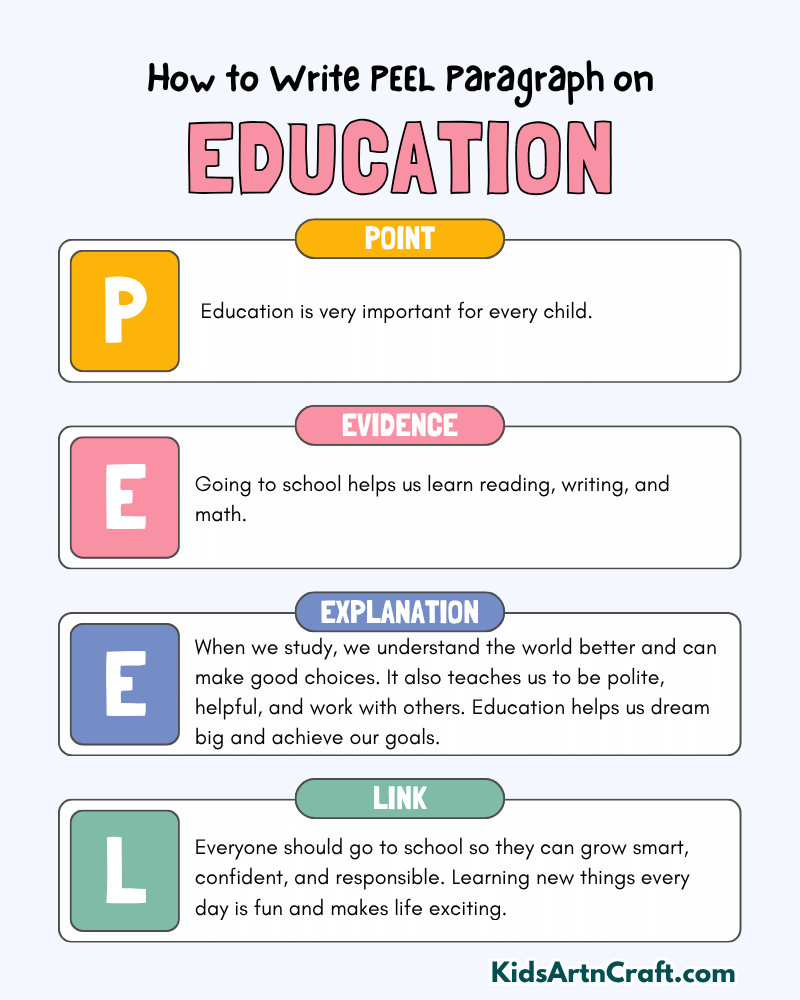
Point: Education is very important for every child.
Evidence: Going to school helps us learn reading, writing, and math.
Explanation: When we study, we understand the world better and can make good choices. It also teaches us to be polite, helpful, and to work with others. Education helps us dream big and achieve our goals.
Link: Everyone should go to school so they can grow smart, confident, and responsible. Learning new things every day is fun and makes life exciting.
2. Education Paragraph Writing with TEEL Method
TEEL Method (Topic, Evidence, Explanation, Link)
Topic: Education helps children grow.
Evidence: For example, reading books improves our imagination, and learning numbers helps solve problems. School also lets us make friends and share ideas.
Explanation: It teaches skills, knowledge, and good behavior.
Link: Education is the key to a bright future. Children who study regularly become capable and confident adults.
3. Education Paragraph Writing with the TEXAS Method
TEXAS Method (Topic, Example, Explanation, Analysis, Summary/Significance)
Topic: Education is important for kids.
Example: For instance, learning science explains how plants grow, and history teaches about past events.
Explanation: It gives knowledge and helps develop skills.
Analysis: Education improves thinking and prepares us for life challenges.
Summary: Going to school regularly and studying well ensures we grow smart, responsible, and ready for the future.
4. Education Paragraph Writing with Hamburger Method
Hamburger Method (Top Bun, The Fillings, Bottom Bun)
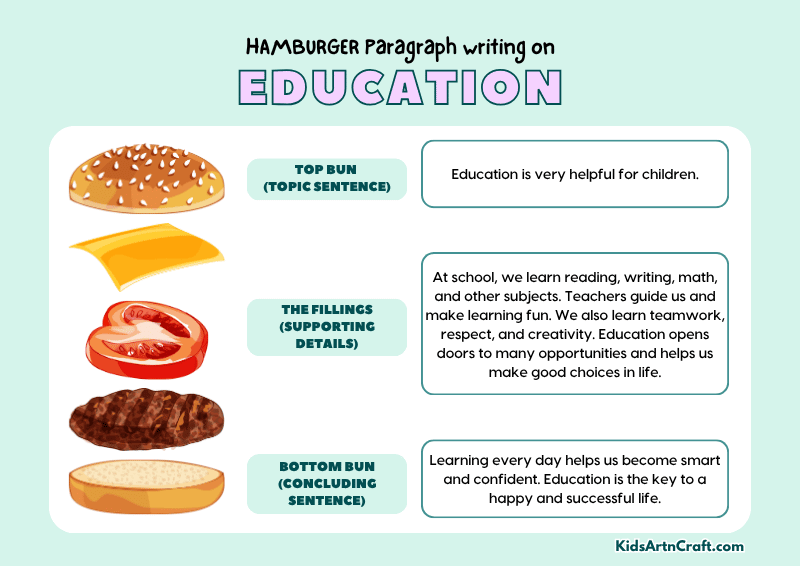
Top Bun (Topic Sentence):
Education is very helpful for children.
The Fillings (Supporting Details):
At school, we learn reading, writing, math, and other subjects. Teachers guide us and make learning fun. We also learn teamwork, respect, and creativity. Education opens doors to many opportunities and helps us make good choices in life.
Bottom Bun (Concluding Sentence):
Learning every day helps us become smart and confident. Education is the key to a happy and successful life.
Hope you liked these paragraphs on ‘Education’. Don’t forget to join the Telegram group for FREE Printables.
Check this article to learn something with this Educational Fun Activities Video Tutorial for Kids.










